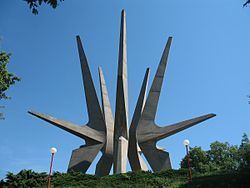Elevation 626 m | ||
 | ||
Similar Avala, Bukulja, Rudnik, Fruška Gora, Maljen | ||
Mtb street view 75 kosmaj serbia belgrade to mt kosmaj 3 4 kosmaj 07 2013
Kosmaj (Serbian Cyrillic: Космај, [kɔ̌smaːj]) is a mountain south of Belgrade, the capital of Serbia. With an elevation of 626 meters, it is the highest point of the entire Belgrade City area and is nicknamed one of two "Belgrade mountains" (the other being the mountain of Avala).
Contents
- Mtb street view 75 kosmaj serbia belgrade to mt kosmaj 3 4 kosmaj 07 2013
- Map of Kosmaj RogaC48Da Serbia
- Mtb street view 130 serbia aran elovac tour 1 from mt kosmaj to aran elovac 08 2014
- LocationEdit
- EtymologyEdit
- GeographyEdit
- SettlementsEdit
- WildlifeEdit
- TourismEdit
- References
Map of Kosmaj, Roga%C4%8Da, Serbia
Mtb street view 130 serbia aran elovac tour 1 from mt kosmaj to aran elovac 08 2014
LocationEdit
The Kosmaj, is located 40 kilometers south-east of Belgrade. Entire area of the mountain belongs to the Belgrade City area, majority of it being in the municipalities of Mladenovac and Sopot, with eastern slopes being in the municipality of Grocka, and northern and north-western extensions in the municipalities of Barajevo and Voždovac.
EtymologyEdit
It is speculated that the mountain was named after the Celtic word cos meaning woods, and maj pre-Indo-European word meaning mountain. Alternative explanations suggest the connection to the ancient mountain-dwelling Slavic pagan deity Kozmaj/Kasmaj, the protector of woods, animals and the cosmos. The mountain has never been known under any other name, until it was forcefully molded by the Romans into "Casa Maias", house of Maia, in order to promote worship of their goddess of spring among the locals.
GeographyEdit
The mountain is 5.5 kilometers long and built of flysch, serpentine, and magmatic rocks. The highest peak is also named Kosmaj. It is a low, island mountain, the second northernmost in Šumadija region (after Avala). Until 600,000 years ago, when the surrounding low areas were flooded by the inner Pannonian Sea, the Kosmaj was an island, just as the neighboring mountains (Avala, Fruška Gora to the north, etc.), thus earning its geographical classification. The Kosmaj remains an island mountain as the plateaux around it are low and mostly flat. In the north it extends into the direction of Trešnja, the southernmost extension of the Avala, while in the north-west it extends into Parcanski vis ("Parcani rising"), 408 meters high ending section of the Kosmaj, which extends into the woods of Lipovička šuma.
In Roman period, Kosmaj was an important mining center, but today the mining activities ceased completely. Evidence suggest that the iron ore was extracted even in the pre-Roman period.
The Kosmaj is source of several rivers. Turija river (and several of its tributraries, including Sibnička reka), which springs right below the mountain and flows to the west into the Kolubara River. Other originate below the Parcanski vis: Lug (or Veliki Lug) which flows to the east into the Kubršnica, Ralja also flows to the east into the Jezava, outflow of the Velika Morava, and Topčiderka which flows to the north, into the urban center of Belgrade.
SettlementsEdit
Except Mladenovac (23,653 inhabitants by the 2002 census of population) on the south-eastern slopes, other settlements, though numerous, are smaller, barely exceeding 2,500 inhabitants. They include Rogača (1,046), Drlupa (590), Dučina (736), Sopot (4,300), Nemenikuće (2,058), Stojnik (642), Babe (332), Guberevac (646), Ralja (2,858), Parcani (657) (in the municipality of Sopot), Amerić (807), Koraćica (1,924), Velika Ivanča (1,796), Pružatovac (835) (in the municipality of Mladenovac), Barajevo (8,325) and Lisović (1,057) (in the municipality of Barajevo).
WildlifeEdit
Together with the Avala, the island of Veliko Ratno Ostrvo and the wood of Stepin Lug (and with forests of Košutnjak and Topčider to be added soon), the Kosmaj is a part of the circle of the protected green areas of Belgrade. The Kosmaj remained forested, mostly by the deciduous (beech and oak), and to the lesser extent, coniferous woods. Altogether, 600 plant and 300 fungi species inhabits the mountain, including the endangered larkspur (Delphinium phissum) which is on the Red List. Cleared areas are mostly used as pastures or are being cultivated as orchards and vineyards. Animals inhabiting the mountain include 50 mammal and 100 bird species, including the more common hares, roes, pheasants, foxes, partridges and quails but also in Serbia rare, Red Listed corn crake and 17 newly discovered species of Sesiidae. Wolves, once living on Kosmaj, are extinct from the mountain.
TourismEdit
The Kosmaj is touristically well prepared for hiking, cycling and touring historic and religious landmarks. It has a hotel, mountaineering camp, villas, etc. Proximity of Belgrade and mountain's gentle slopes, glades and woods are a basis for the touristic economy. Latest addition, since the mid-2000s is a modern, vast resort complex of "Babe", near the village of the same name. Hunting tourism is also an opportunity, because the mountain is rich in game. Several monasteries are located in the mountain's downhill: "Tresije" (from the 15th century), "Kasteljan" (in ruins) and "Pavlovac". There is a mineral spa on the southern slopes, near the village of Koraćica (Koraćička banja). There are two monuments on the top of the mountain, one dedicated to the fallen soldiers of the World War I, the other to the soldiers of the Yugoslav Partisan "Kosmaj Partisan detachment" from the World War II.
